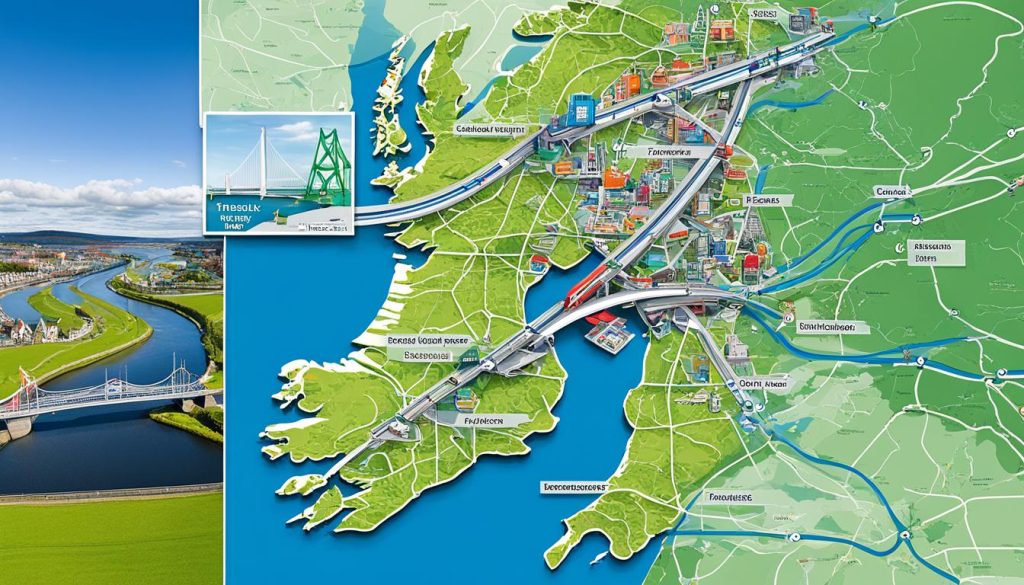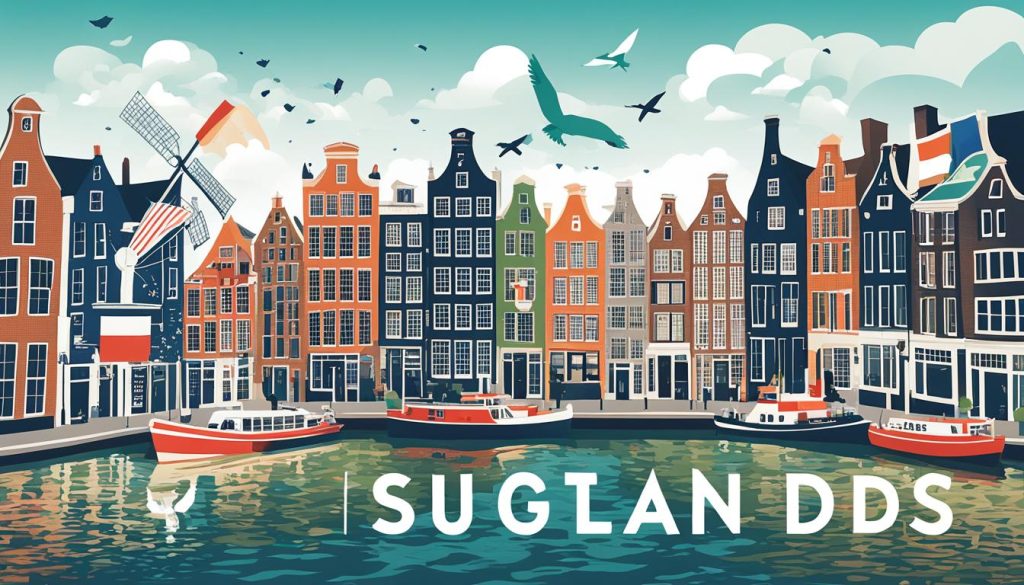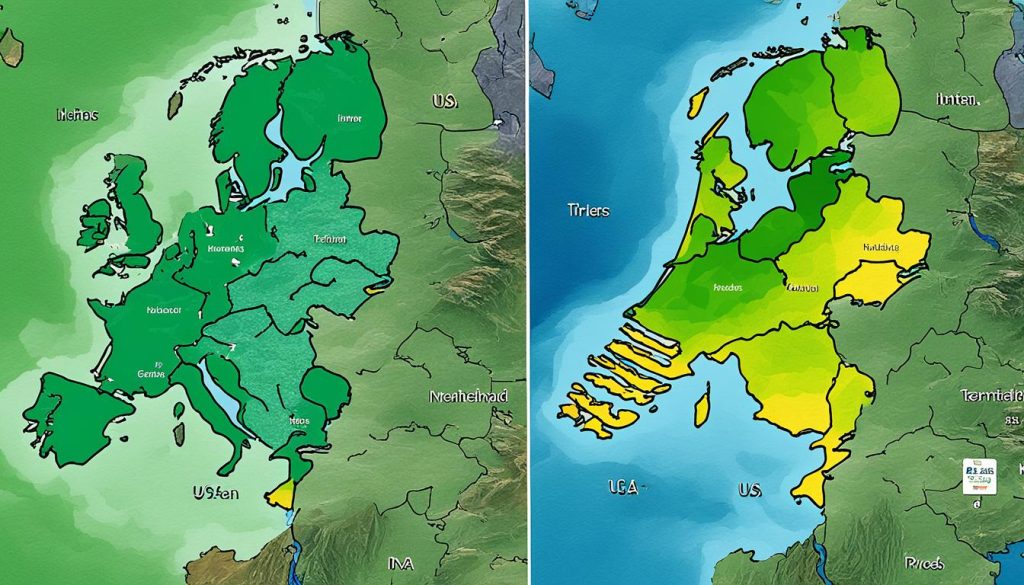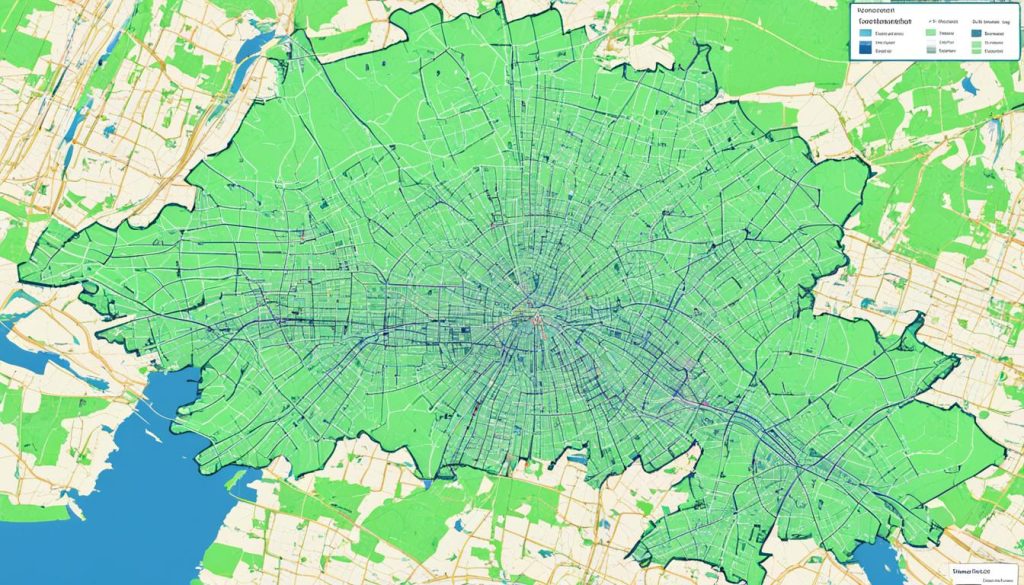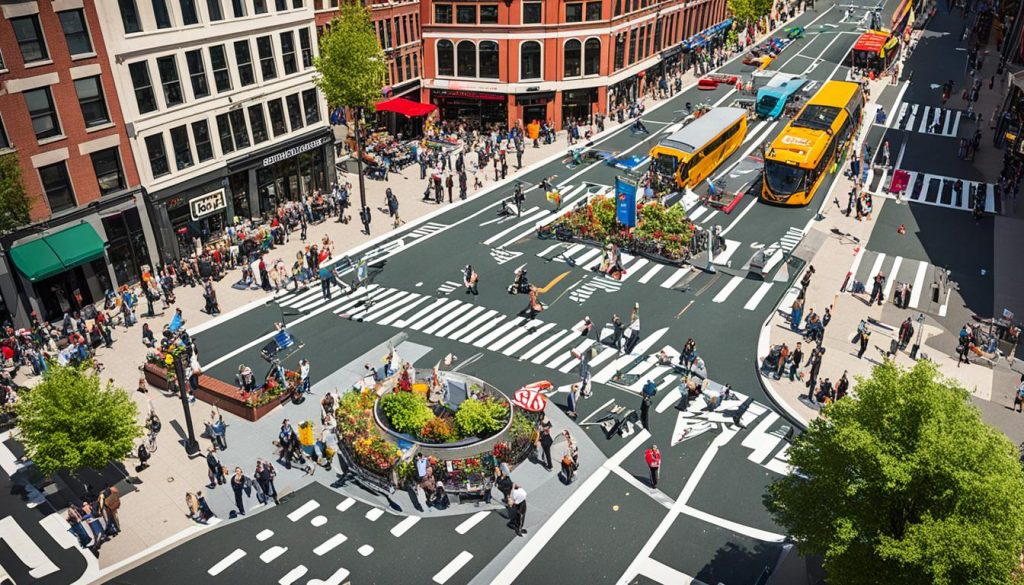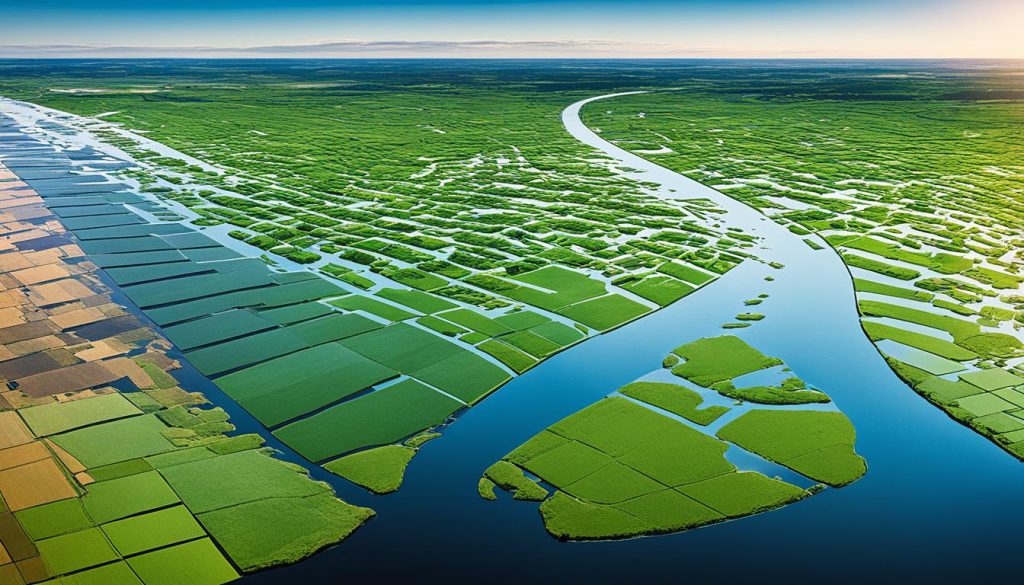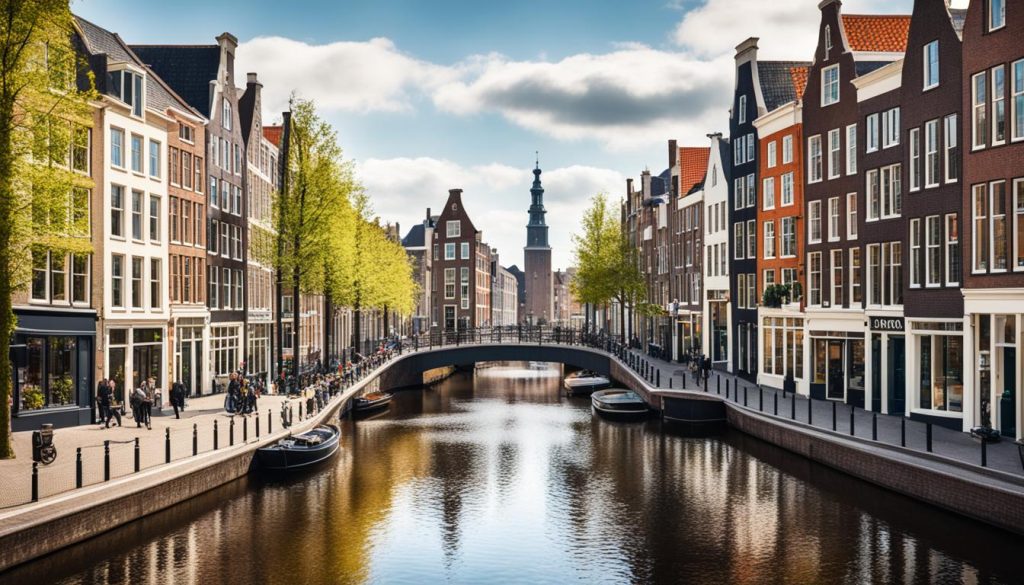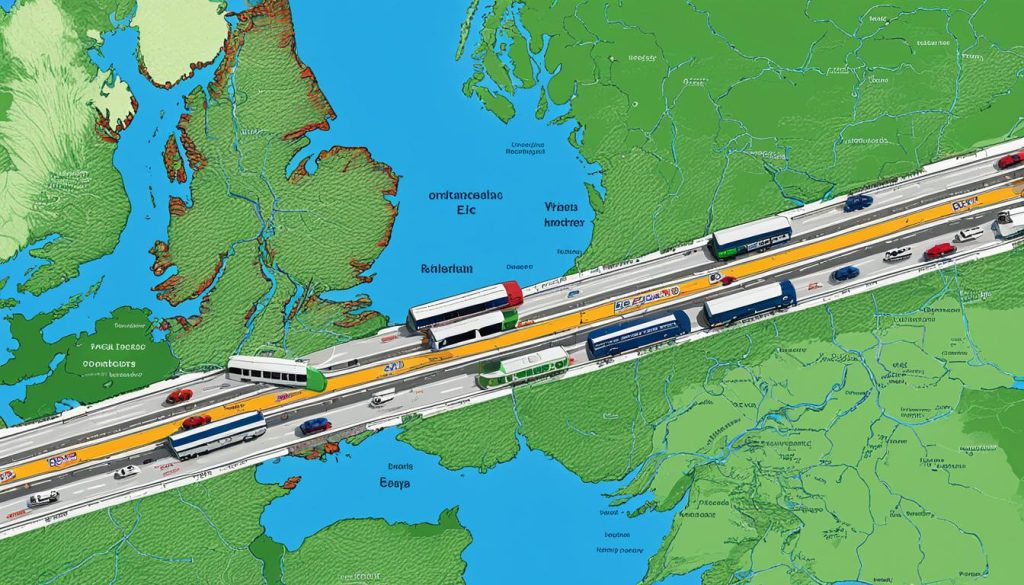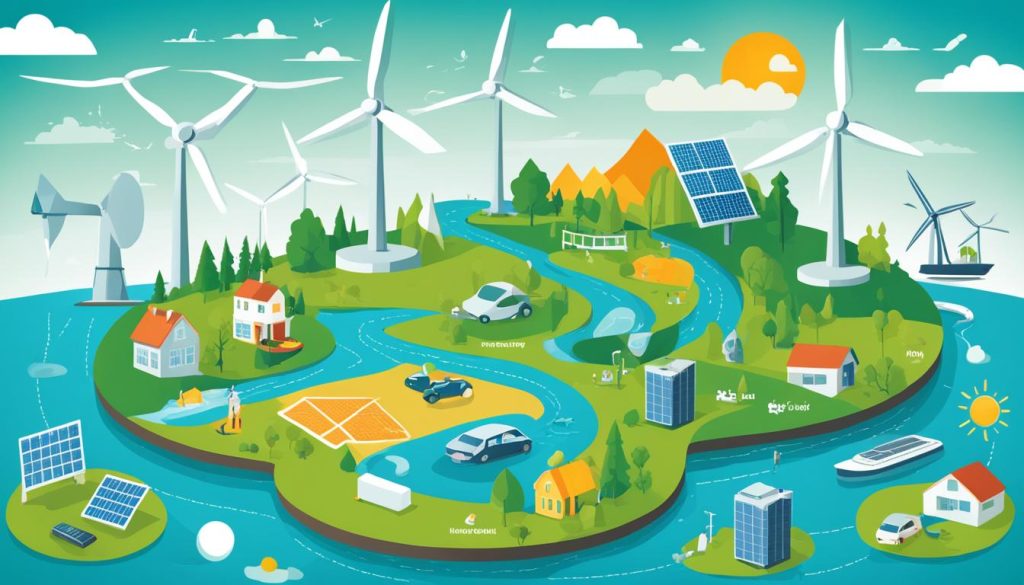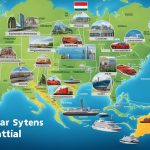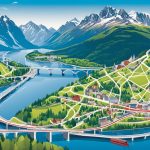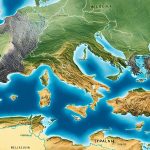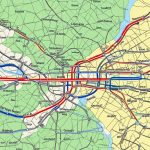Exploring infrastructure comparison and geographical diversity unveils interesting insights among the Netherlands, Ireland, and the USA. Each country showcases diverse terrains and infrastructure. The Netherlands, for example, is densely packed and connected to Europe. Ireland offers vast, historic landscapes. Meanwhile, the USA spans a wide range of geological and infrastructural features.
Discussing the Netherlands, Ireland, and USA, we see how geography influences infrastructure. The Netherlands is famous for its canals, Ireland for its green fields, and the USA for its large cities. This variety shapes each nation’s infrastructure and methods. Join us to explore how natural landscapes define a country’s built environment.
Our journey explores infrastructure comparison and geographical diversity. We’ll look at how these aspects affect the Netherlands, Ireland, and the USA. This conversation goes deep into analyzing the connection between natural and man-made structures. It highlights the crucial role of geography in shaping infrastructure.
Introduction to Geographical Diversity
Looking at the geographic comparison between the Netherlands, Ireland, and the USA reveals an exciting mix of cultural landscapes. Each country has its own special geography. This variety in landscapes not only adds to their beauty but also shapes their cultures and economies.
In the Netherlands, the flat lowlands are a key feature. This shape has led to advanced water management and farming methods. The contrast between the well-planned countryside and the modern cities shows how the Dutch have adapted to their land.
Ireland, on the other hand, has beautiful green hills and rocky coasts. This beautiful scenery is a big part of who they are. It influences their stories, their farming, and their strong bond with the land.
- Rolling green hills and pristine coastal views characterise Ireland’s rural cultural landscape.
- Historic castles and stone walls trace a lineage deeply embedded in the physical geography of the region.
The USA’s geography is incredibly diverse. From freezing arctic areas to hot tropics, the country spans several time zones. Its wide range of climates and terrains supports large-scale farming, technological growth, and city building.
- Snow-capped mountain ranges and arid deserts.
- Lush forests and expansive plains.
- Dynamic urban landscapes set against serene natural parks.
The relationship between different geographical distinctions and their infrastructures is intriguing. It shows how the earth’s various shapes and forms influence human activities.
Analysing the Landscapes: Size and Terrain
An in-depth look at the Netherlands, Ireland, and the USA shows us their vast differences in size and terrain. Each place tells its own story through its land, affecting both its culture and environment. By examining their physical features, we discover how nature shapes each country’s identity.
Contrasting Land Areas
The Netherlands may be small, but it plays a big role in European trade. Its use of space contrasts sharply with Ireland’s wide, green landscapes. Ireland is known for its stunning coastlines and lush fields.
Then, there’s the USA, with its wide range of landscapes. From deserts to mountains, it showcases the diverse face of nature. This variety highlights the vast geographic differences across the continent.
Topographical Features
Each country’s landscape offers insights into its natural heritage. The Dutch coastlines are low and flat, quite unlike Ireland’s hilly bogs and mountains. The USA, on the other hand, boasts dramatic landscapes. These include the towering Rocky Mountains and the vast Great Lakes.
Exploring these landscapes helps us understand the power of nature. By studying their features, we learn about each country’s geography. This not only tells us about their physical world but also their communities and economies.
Urban Expansion and Population Density
Urbanisation trends have notably transformed the landscapes of the Netherlands, Ireland, and the USA. Each country shows unique changes in population statistics and density. In the Netherlands, urban areas are really packed. This shows their high level of urban saturation. Ireland’s urban growth is clear too, especially in big cities like Dublin. The USA, however, shows a mix of very crowded and less crowded places.
Looking into these changes tells us a lot about how these countries develop. It also shows the challenges and benefits that come with growing cities. Here are some key points to understand better:
- High Population Density in the Netherlands: The country’s cities are cleverly built to fit lots of people in small spaces. This is because there’s not much room, due to the high population density.
- Moderating Urban Density in Ireland: Even with growing cities, Ireland keeps its beautiful countryside. Dublin is booming, thanks to tech and finance jobs.
- Urban Diversity in the USA: The USA’s different landscapes lead to various kinds of cities. Big cities like New York City are very different from the country’s rural areas.
The way cities grow is closely tied to population numbers. Cities are now the heart of economic and social life. This change affects both how we live and the economy of countries. It’s clear that managing how many people live in an area and how we use urban spaces is key for a good future.
Cultural Geography: Languages and Ethnicity
The threads of language and ethnicity weave the fabric of society. They craft the culture’s tapestry in countries like the Netherlands, Ireland, and the USA. Looking closely at how languages are spread in these nations helps us understand their multilingual societies and national identities.
Linguistic Distribution
In Europe, the Netherlands mostly speaks Dutch, with Frisian also spoken in Friesland. This blend of languages is key to Dutch culture. Ireland showcases a mix of Irish and English. This bilingual setup adds to its unique cultural identity.
Ethnic Diversity and Demographics
The Netherlands and Ireland are mainly European but have been welcoming people from different backgrounds. The USA is a melting pot of ethnicities, making it rich in cultural and linguistic variety. Together, these nations host diverse ethnic groups living in harmony.
- The Netherlands is evolving with new citizens from the EU and former colonies.
- Ireland is becoming more diverse, adding new layers to its society.
- In the USA, various communities contribute to the nation’s complex ethnic tapestry.
Studying these countries through the viewpoints of language and ethnicity shows us how they cope with being multicultural and multilingual. It gives us a peek into the dynamics that form the unique societies in the Netherlands, Ireland, and the USA.
Climate Patterns Across Three Nations
Exploring the weather in Ireland, the Netherlands, and the United States shows how different their climates can be. These countries have unique temperature ranges. This tells us a lot about how geography affects climate.
Temperate Weathers and Its Variations
Ireland and the Netherlands both have temperate maritime climates. Yet, they have some differences in weather. Ireland gets more rain because of the Atlantic currents. The Netherlands, on the other hand, enjoys more sunny days. This shows even similar climate zones can have varied weather.
Impact of Geography on Climate
The United States is a prime example of how geography influences climate. It has diverse landscapes and latitudes. Because of this, the USA sees many types of weather. From Alaska’s cold to California’s heat, the USA’s climates show how nature’s factors create different weather patterns.
- Ireland: A temperate maritime climate with generous rainfall, giving it its lush green landscapes.
- The Netherlands: Similar climate with moderated conditions due to its coastal geography and fewer weather extremes.
- The United States: Home to a broad spectrum of climatic conditions varying across its 50 states.
Looking closely at the number ‘7’ tells us about the variety in climates among these nations. It stands for the complexity of weather around the world. It shows how parts of each country share similar weather patterns with places far away. This highlights the amazing links between global climate systems.
Infrastructure Development and Quality of Life
The link between quality of infrastructure, living standards, and development indices is crucial for a country’s wellbeing and growth. The Netherlands stands out with excellent infrastructure that boosts living conditions and ranks high on development charts. In Ireland, great infrastructure faces challenges from high living costs, affecting overall life quality.
In the USA, the situation varies from state to state. Where infrastructure gets focus, people enjoy better healthcare, schools, and transport. This leads to improved living standards and positive development scores. It shows how connected infrastructure, quality of life, and growth are.
- Infrastructure’s role in achieving high living standards.
- The discrepancy of living costs as a barrier to quality of life.
- Regional variations in the USA’s infrastructure and its impact on development indices.
Sustained investment and smart planning in infrastructure lead to higher living standards and better development scores. These elements are key to improving society’s wellbeing and achieving rounded national growth.
Examine Roadways, Railways and Waterways
A close look at the Netherlands, Ireland, and the USA shows their dedication to effective transport systems. This shows how important transport is for a country’s socio-economic development.
Transport Network Comparisons
The Netherlands and Ireland might be small, but their transport networks are impressive. This is due to careful planning that meets modern needs. These countries make it easy to switch between different types of transport.
In addition, the Netherlands shines with its major waterways. These are key for trade within Europe.
Accessibility and Mobility
When judging infrastructure efficiency, looking at how easy it is to get around is crucial. The Netherlands and Ireland focus on making movement easy for everyone. They have paths for walking and cycling next to their public transport.
The USA, with its large area, has a big interstate system and many railroads. These connect its regions and cater to moving goods and people. Different states have different transport tastes. Some cities are leading the way in making transport more sustainable.
- Comparative density of the transport networks in the Netherlands and Ireland relative to their geographic sizes.
- Scope and scale of the American transport infrastructure and its reflection of the nation’s large geographic expanse.
- Pedestrian pathways and the blend of accessibility options available in European nations.
- The USA’s move towards a more sustainable and efficient transport system in select urban areas.
Energy and Power: A Sectoral Comparison
When we look at the energy sector’s importance today, it’s key to note the different methods and power across nations. The Netherlands, Ireland, and the USA each show their unique strengths and facing challenges in power generation and green energy efforts. As we move to energy systems that mix effectiveness with caring for the environment, these nations show the worldwide push to match energy needs with being sustainable.
Energy Production Capacities
The Netherlands is notable for its large energy production abilities, helped by a strong export level. With wind power from the North Sea and its gas extraction skills, it’s key in Europe’s energy picture. Meanwhile, Ireland, though smaller, has managed to be self-sufficient in energy, making big steps in using sustainable sources. Despite its size, Ireland is a leading example in Europe for embracing renewable energy.
Consumption Patterns and Renewable Initiatives
Looking at energy use, the Netherlands and the USA both have high energy consumption per person, showing their strong industries. Ireland’s consumption is less but slowly increasing as it grows. All three countries are actively adopting renewables in their energy plans. This move is vital in the change towards sustainable energy, highlighting the aim to be innovative in energy policy around the world.
Telecommunications in Netherlands, Ireland, and USA
Our world is deeply connected through information. This makes a strong digital infrastructure very important. The Netherlands, Ireland, and the USA lead in technology, showing great achievements in connectivity advancements. Their efforts in boosting telecommunication networks show they are committed to growth.
Advancement in Connectivity
The Netherlands and Ireland have quickly improved their broadband and mobile networks. They aim to be top in Europe’s digital scene. Meanwhile, the USA’s networks are big and innovative, showing its tech power. These countries offer a wide range of services, making them stand out.
Internet Penetration and Usage
High internet penetration is key to closing the digital gap, and it’s thriving in these countries. People here have fast and wide internet access. This is true for work, learning, or fun. Improving digital infrastructure is always the main goal.
This digital spread supports economic and social growth. It makes countries stronger in our info-rich world. Being digitally connected is essential for their future success.
Agriculture and Arable Land Utilisation
The use of arable land varies across the Netherlands, Ireland, and the USA. This shows the variety in global agriculture. Each country’s farming practices are shaped by its own climate and geography. This showcases human ingenuity in farming.
In the Netherlands, where arable land is scarce, farming is highly efficient. The Dutch use advanced technologies and intensive farming to get the most out of their land. This makes the Netherlands a top exporter of farm goods, helping its economy despite its small size.
- High-tech greenhouse systems
- Precision agriculture
- Added value agri-food production
Ireland benefits from a naturally green landscape that suits farming well. Its agriculture leans towards pasture-based systems for dairy and beef. These sectors are key to Ireland’s farm output and rural life.
- Grass-fed livestock farming
- Sustainable crop rotation
- Organic produce cultivation
The USA is an agricultural giant with varied climates and lots of land. Its farming includes large industrial setups and small, sustainable family farms. The USA shapes global food markets and farming trends with its blend of old and new ways.
- Large-scale commercial farming
- Boutique organic markets
- Development of bioengineered crops
Although their methods and size differ, these countries highlight the importance of innovation and sustainability in farming. Combining smart practices, environmental respect, and technology will keep these sectors thriving into the future.
Healthcare Infrastructure: A Comparative Overview
When we look into healthcare systems of three very different countries, we see what works and what needs improvement. Each country’s healthcare tells us about the medical care they offer and the challenges they face. The healthcare quality also helps us understand how a country takes care of its people.
Hospital Beds and Healthcare Professionals
The Netherlands and Ireland do well in terms of hospital beds and healthcare professionals per person. They show strong healthcare systems with easy access to medical services and good patient care. However, the USA, despite having advanced technology, struggles with enough hospitals and healthcare workers. This affects how equally people can reach healthcare.
Public Health Achievements and Concerns
Countries’ success in healthcare also shows up in their public health results. The Netherlands and Ireland stand out thanks to their health policies and investments. But the USA faces hurdles, like unequal healthcare access and high costs. These issues affect how effective healthcare is for everyone.
Compare Geography and Infrastructure between Netherlands, Ireland and USA
The link between geography and infrastructure is key for growth in any country. Each nation’s location shapes its development in unique ways. In this part of our series, we look at how the Netherlands, Ireland, and the USA use their geography to boost their infrastructure.
These countries show how geography helps build strong infrastructures. They stand out globally because of this. As we go deeper, we’ll see how their landscapes and resources have led them down different development paths.
Geographical Influence on Infrastructure
The Netherlands is small but has a dense transport and trade network. It shows how geography can spur development beyond a country’s size. Ireland uses its beautiful landscapes and coasts to strengthen its tourism and maritime sectors. It turns natural beauty into an economic asset.
The USA’s huge area affects its infrastructure, covering different climates and landscapes. The Rocky Mountains and the Great Plains, for example, have shaped sectors like agriculture and transportation.
Policy-Driven Infrastructure Development
Policies are crucial in making the most of geography for building infrastructure. The Netherlands and Ireland gain from EU policies, which help fund their projects. These policies support sustainable development and better connectivity.
The USA’s infrastructure policies come from both federal and state levels. Despite their variety, they aim to boost national development, focusing on geographical and regional needs. The federal government plays a big role in infrastructure, showing how policies and geography work together.
In this analysis, we see geography’s role in development. But, strategic policies are also needed to fully use geographical benefits. The Netherlands, Ireland, and the USA have succeeded by combining natural and policy strengths.
International Trade and Economic Geography
International trade and economic geography reveal how trade balances and export-import ratios are crucial. These factors help us understand national wealth. Ports and markets around the world show the flow of goods and services.
Export and Import Dynamics
The Netherlands shines in international trade, thanks to the port of Rotterdam. This helps the country’s trade balance and global market position. The nation uses its location to boost trade and show its power through good export-import ratios.
Ireland’s success comes from exporting high-tech goods. Even with fewer goods, it makes a strong mark in global trade. This approach moves Ireland upward in the world economy.
The USA plays a big role in global trade with its large amount of goods. Its vast lands help in spreading economic activities worldwide. This affects global trade and the balance of exports and imports.
Currency and Cost of Living Analysis
The Netherlands and Ireland using the Euro boosts trade in the European Union. It helps both countries with their economic plans. This includes how they spend and invest.
Ireland’s cost of living is a bit high, despite its beautiful landscapes. On the other hand, the Netherlands balances affordability with a good economy. The USA, with its strong economy, uses the dollar to cover various living costs.
Military Strength and Strategic Geographical Positions
The way we look at a nation’s defence power includes checking its military strength and key locations. For example, the Netherlands uses its spot in Western Europe to build a strong military force. This is boosted by its role in the North Atlantic Treaty Organisation (NATO). The country is known for innovative military tech. Its forces work well within global alliances.
Ireland, however, focuses on peace due to its neutral stance. It takes part in peacekeeping with the United Nations. Even without a big army, Ireland makes important contributions through diplomacy and solving conflicts. Being an island by the edge of Europe, Ireland plays a key role in keeping an eye on North Atlantic activities.
Then, there’s the United States, showcasing massive military power. It has many key spots around the world. This helps the US maintain its superpower status with a strong base network and a powerful navy. Its global presence means it can quickly respond to security issues. This makes the US a leading force in world defence stories.
- The Netherlands: NATO-aligned military known for technological innovations.
- Ireland: A commitment to global peacekeeping shaped by neutrality.
- The USA: Diverse strategic locations support unparalleled military strength.
Top strategists often say that military force isn’t just about weapons. It’s also about where a country is located. Geography can help or hinder a nation’s defence and its power projection. It affects how well a country can protect itself.
This mix of military strength, location, and overall defence plans is complicated but vital. It’s key to understanding how countries relate and compete on the world stage.
Conclusion
Our study of geography and infrastructure across countries shows how deep the relationships are. The Netherlands uses its space wisely and has strong transport networks. Ireland is known for its beautiful landscapes and growing tech sector. The USA shows a wide range of geography and infrastructure. Each country has its own way of blending geography with infrastructure development.
The stories of these countries highlight the impact of geography on a nation’s economy and culture. The Netherlands is dense with infrastructure due to its small size. Ireland attracts tourists with its natural beauty. The USA shows different infrastructure in each region, matching its vast geography. This shows the strong link between a country’s physical features and its development.
For those making policies, it’s clear that geography and infrastructure shape a nation. This affects culture and how countries are viewed globally. Investors and the world should know that a country’s geography and its infrastructure growth are key. They are essential for progress and for being part of the global community.

